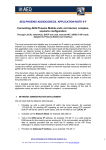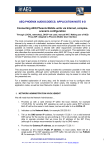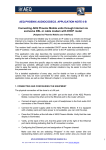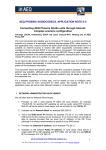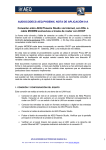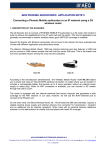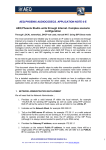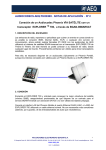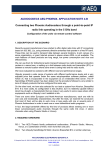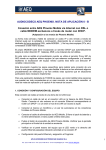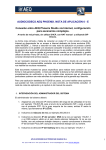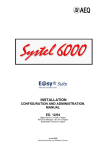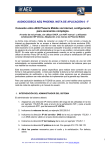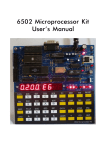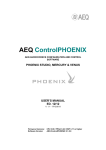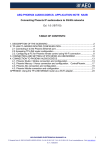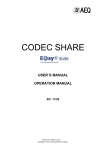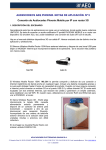Download AN 0A
Transcript
AEQ PHOENIX AUDIOCODECS. APPLICATION NOTE 0-A Connecting AEQ Phoenix Studio units through Internet via exclusive DSL or cable MODEM with DHCP router The most convenient and reliable way to connect an IP codec to a remote one through Internet is by means of a dedicated, exclusive Internet access (DSL, cable modem) as described below. No other equipments (PC, etc) are connected to this same access. The modem itself usually has an embedded DHCP server that automatically assigns valid IP address / mask, gateway and DNS server to the IP system(s) connected to it. This application note also describes the recommended procedure when AEQ SIP Proxy is used, where both equipments involved in the communication are registered, easing the task of finding the remote IP address when it is variable or unknown. This document shows the specific steps to make this connection possible in the most general way possible, although some verification procedures have been omitted in order to ease the reading, and some particular situations may be easier to solve that the presented one. For a detailed explanation of every step, and for details on how to configure other options that may be more convenient for other cases, the reading of the rest of application notes, as well as User Manual’s chapter 4, is recommended. 1. CONNECTING AND CONFIGURING THE EQUIPMENT The physical connection will be done to a LAN port. • Connect the network cable to the LAN1 port at the back of the AEQ Phoenix Studio. Connect the other end to the Ethernet port we have been assigned within the LAN. • Connect the analog or digital audio inputs and outputs to the connectors at the back of the AEQ Phoenix Studio. • Connect the IEC mains cable to the back of the AEQ Phoenix Studio. • Turn the power switch ON and verify that the front display shows the AEQ logo after some seconds. • Verify that the green LED in the connected Ethernet port at the back of the equipment blinks indicating that there is traffic in the IP connection. • Configuring the ETH1 port: Go to menu MAIN STATUS SYSTEM 8.SETTINGS ETHERNET SETTINGS ETHERNET MODULE 1, where we will set up the following parameters: APLICACIONES ELECTRONICAS QUASAR S.A. TEL: (34) 91 686 13 00 - FAX: (34) 91 686 44 92 - E-mail: [email protected] - Web: 1 www.aeq.eu DHCP ON The following parameters should be automatically configured: Local IP address, for example 192.168.1.22 Gateway IP address, for example 192.168.1.1 Network Mask, for example 255.255.255.0 DNS Server IP address, for example 192.168.1.1 Ethernet 1 port configuration screen • Select the PROXY SIP operating mode, from the menu MAIN STATUS SYSTEM 5. INTERFACES NET 1 MODE 2. OTHER POINTS TO CHECK We are now going to quickly overview the rest of configuration menus where it is recommended to check that every parameter is correctly configured. At MAIN STATUS… Chn1: Net 1 ONLY G722 OK (Press the encoder button “SEL” to modify the parameters this channel’s parameters): INTERFACE: Net 1 ( IP) CODING( List) : ONLY_G722 for a start, we can test other modes with better quality afterwards. If the coding lists need to be edited, select option 10 from SYSTEM menu. AUDIO IN SOURCE: ANALOG for analog XLR inputs. BACK UP: Set it up afterwards only if backup on other physical interface is needed. RX BUFFER MODE: ADAPTATIVE RX BUFFER (MAX): 1000 (in milliseconds. It should be reduced dynamically if no dropouts are detected) Rest of parameters: set them up after reading the manual and according to each particular need. APLICACIONES ELECTRONICAS QUASAR S.A. TEL: (34) 91 686 13 00 - FAX: (34) 91 686 44 92 - E-mail: [email protected] - Web: 2 www.aeq.eu Net 1 : PROXY SIP OK. (Press the encoder button “SEL” to modify the parameters this logical interface’s parameters): MODE: PROXY SIP. If this is not the set mode, press the encoder button to change it to MODE: PROXY SIP. Press ADVANCED soft key to gain access to the logical interface configuration: Go to USER and check that USER NAME matches a user that is registered in AEQ SIP proxy. Go to AUTHENTICATION, and check that USER has the same value as the previously mentioned USER NAME parameter. Check that a correct password is introduced and that REALM is “sip.aeq.es”. Access AUDIO menu and check that: LOCAL INTERFACE is ETH1 LOCAL PORT is the same that the network administrator has opened for audio (paragraph 1.6), 5004 by default. SYMMETRICAL RTP is ON Go to NAT TRAVERSAL, check that MODE: AUTO3 (or AUTO4 only in case you are not using the AEQ Proxy SIP server and you find problems with AUTO3). In both cases, STUN should be activated. It is by default, and the IP address of a valid STUN server is filled as well. At the moment of writing this document, the STUN server chosen is stun.voxgratia.org, with IP address 83.103.82.85. If problems are found in the connection and the STUN is suspicious (you can check this, for example, by sending a Ping request to this IP address*) contact AEQ SAT for a more updated STUP IP address. *Not all STUN servers respond to PING requests even if they are reachable and operative. If it responds, we know for sure that it works, but if not, we cannot ensure that it is not. 3. REGISTERING AT THE AEQ SIP SERVER At this point, we will check that we are able to access Internet and reach AEQ SIP server, available at the host ”sip.aeq.es”, that at this moment has the IP address 82.165.157.20. Check, entering MAIN STATUS SYSTEM 9 SIP PROVIDERS AEQ menu, that NAME: AEQ HOST: sip.aeq.es APLICACIONES ELECTRONICAS QUASAR S.A. TEL: (34) 91 686 13 00 - FAX: (34) 91 686 44 92 - E-mail: [email protected] - Web: 3 www.aeq.eu If the DNS field referred to in the previous chapter was not configured, you can change the HOST name by its updated IP (HOST: 88.2.202.39 at the time of writing this document) PORT: 5060 DOMAIN : sip.aeq.es. REGISTER : YES EXPIRES: 60 INTERFACE: ETH1(Main) If everything has been correctly configured, the line corresponding to Ch1 at the MAIN STATUS screen should show, for example: Chn 1: Net 1 ONLY G722 OK …It should end with “OK”. If something is wrong, the end of this line will temporarily show REGISTERING and definitely become REGISTER ERROR. For example: Chn 1: Net 1 ONLY G722 REGISTER ERROR 4. MAKING A TEST CALL TO PHOENIX MASTER Finally, we are going to revise the adequate configuration of the equipment, and prepare it to make a test call to an unit called [email protected] , that AEQ maintains for its customers, continuously transmitting audio and reachable in the public IP 212.170.163.189 (at the time of writing this document) We recommend that a pair of headphones is plugged to the front outlet, or a couple of monitor speakers are connected to the back side XLR outputs. It is also advisable that the PHOENIX MASTER is added to the phone book for future tests: Go to MAIN STATUS SYSTEM 2. CONTACTS, screen PHONE BOOK. Press the soft key INSERT. Following the guidelines in chapter 3.1.2 of the User Manual, fill a name and URI for Phoenix Master (have in mind that “*” key switches between upper case, lower case and numbers, and that the space is inserted with key “0”): NAME: PHOENIX MASTER TEL: <leave this field blank > TEL2: <leave this field blank> APLICACIONES ELECTRONICAS QUASAR S.A. TEL: (34) 91 686 13 00 - FAX: (34) 91 686 44 92 - E-mail: [email protected] - Web: 4 www.aeq.eu URI: [email protected] (case sensitive) We could also type the name, IP and port of the equipment instead of the name and domain. At the time of writing this application note, it is: URI: [email protected]:5061 Return to MAIN STATUS screen and place the cursor over Chn1. Press the CALL key associated to the first channel of the audiocodec, which is the leftmost one of two keys at the front panel of AEQ Phoenix Studio. This will present the connection configuration menu, CH1 CALL MENU Press PHONE BOOK, place the cursor over “PHOENIX MASTER” entry that we previously created, and press DIAL soft key to initiate the call. • The OLED screen (sometimes fast) the status call status and the different phases it steps through: CALLING, CONNECTING, SYNCHRONIZING and finally CONNECTED. • Verify that the SYNC LED situated under the CALL key is lit in green color, as an indication that the communication has been correctly established and synchronized. You should hear audio from Phoenix Master in the headphones. Established connection detail • Be sure that ON AIR is activated for that communications channel in order to allow the full-duplex audio transmission from/to the associated XLR connectors. Once the connection is well established, it can be repeated as many times as necessary varying the audio coding algorithm until the best possible quality is reached given the network conditions. (Menu CH1 STATUS CODING (List).) The audio coding algorithm lists are created by entering MAIN STATUS SYSTEM 10. SIP CODEC PROFILES APLICACIONES ELECTRONICAS QUASAR S.A. TEL: (34) 91 686 13 00 - FAX: (34) 91 686 44 92 - E-mail: [email protected] - Web: 5 www.aeq.eu 5. MAKING A CALL TO OTHER PHOENIX CODEC OR TO A N/ACIP COMPLIANT CODEC The call to Phoenix Master has been automatically answered. To make a manual call to other codec, it is necessary to configure the second one the same way, if it is connected to Internet directly through an ADSL router or cable modem with DHCP server, or following the appropriate Internet application note (AN0C to AN0F) if it is connected to a managed local network. Once the reporter unit can connect properly to Phoenix Master, you can create in the phone book a contact with the name and URI of the other unit as explained for the Phoenix Master contact in the previous chapter, and the call can be directly made. You can also send the call without having previously created a contact in the Phone Book. Just select the Chn 1 line in the MAIN STATUS screen, press the CALL key corresponding to CH1 (the leftmost one), and you will reach CH1 CALL MENU. Then select the URI line and edit it in order to type the other equipment’s URI. Now just validate by pressing the encoder button and press the DIAL soft key. The other equipment CALL LED will blink and the buzzer will sound if it is configured to do so. When you press the blinking CALL key, the communication should be established, and the SYNC LED should become green in both ends of the communication. If you press the ON AIR key the audio from the XLR input will be sent, and the audio from the opposite unit should be received in the headphones. In order to set the buzzer, go to MAIN STATUS select BUZZER = ON SYSTEM 8 – SETTINGS and For more information and other configuration options, please read the User Manual and Application Notes corresponding to other scenarios. If you still have doubts, please don’t hesitate to contact one of our assistance services: [email protected] [email protected] APLICACIONES ELECTRONICAS QUASAR S.A. TEL: (34) 91 686 13 00 - FAX: (34) 91 686 44 92 - E-mail: [email protected] - Web: 6 www.aeq.eu






